A freestanding bathtub is a centerpiece that exudes luxury and style when creating a luxurious and elegant bathroom space. Seeing a freestanding bathtub invokes a sense of relaxation and indulgence, transforming your bathroom into a spa-like retreat. This comprehensive buying guide will walk you through everything you need about choosing the perfect freestanding bathtub for your home.
What are The Benefits of Freestanding Bathtub?
1. Luxurious Aesthetics
- Timeless and sophisticated appearance
- Elevates the overall ambiance of the bathroom
- Elegant and standalone design
- Serves as a focal point
- Adds a touch of grandeur to the space
2. Versatile Placement
- Freestanding tubs offer greater flexibility in bathroom design
- They can be placed anywhere in the bathroom
- Unlike built-in bathtubs, freestanding tubs provide more options for creating your ideal bathroom layout
3. Various Materials
Freestanding bathtubs come in various materials:
- Acrylic
- Cast iron
- Stone
- Copper
- Each material has its unique charm and aesthetic appeal.
Different materials require different maintenance levels:
- Acrylic: Easy to clean and lightweight.
- Cast iron: Durable but may require periodic refinishing.
- Stone: Natural and luxurious, needs proper sealing and care.
- Copper: Elegant and can develop a patina, requires specific cleaning methods.
4 Factors to Consider Before Buying Guide to Freestanding Bathtub
1. Size and Space
- Measure the available space in your bathroom as the first step in selecting a freestanding bathtub.
- Consider the dimensions of the tub to ensure it fits comfortably in the space.
- Avoid selecting a bathtub that makes the bathroom feel cramped.
2. Material
Acrylic:
- Contemporary and lightweight
- Excellent for modern aesthetics
Cast Iron:
- Classic elegance and sturdiness
- Timeless appeal
Stone:
- Natural beauty and unique look
- Adds a touch of luxury
Copper:
- Charming and rustic appeal
- Unique and eye-catching design
3. Style and Design
- Freestanding bathtubs come in diverse shapes and designs
- Options range from classic oval and rectangular to unique and artistic forms
- Select a style that complements your bathroom theme
- Reflect your personal taste in the chosen bathtub design
4. Comfort and Ergonomics
- Ensure the bathtub has an aesthetically pleasing design for visual appeal
- Prioritize comfort by considering the depth of the tub
- Pay attention to the contour of the tub to provide ample support during bathing
- Aim for a design that promotes relaxation while soaking
Pros and Cons of Freestanding Bathtubs
1. Luxurious Aesthetics
- Freestanding bathtubs elevate the bathroom with elegance and luxury
- Creates a spa-like ambiance for enhanced relaxation
- Adds a touch of indulgence to the bathing experience
2. Versatile Placement
- Freestanding tubs offer flexibility in bathroom design
- They can be placed anywhere in the bathroom
- Unlike built-in bathtubs, they are not restricted by specific locations
- Provide more options for creative bathroom layouts
3. Focal Point
- Standalone design
- Freestanding bathtub
- Focal point in the bathroom
- Draws attention
- Becomes a centerpiece
- Elevates overall décor
4. Variety of Materials
Freestanding bathtubs are available in a variety of materials:
- Acrylic
- Cast iron
- Stone
- Copper
- This diversity allows homeowners to select a style that suits their personal taste and complements their bathroom theme.
5. Unique Designs
- Freestanding bathtubs come in various sizes, catering to different spatial requirements.
- A diverse range of shapes is available, allowing homeowners to select a design that suits their preferences.
- Different styles of freestanding bathtubs provide options to complement individual tastes and personal decor.
- Homeowners have the flexibility to choose a bathtub that aligns with their unique style preferences.
6. Comfortable Bathing Experience
- Freestanding bathtubs feature ergonomic designs
- Designed for a comfortable bathing experience
- Offers an immersive and relaxing feel
- Notable for their stand-alone placement
- Enhances the aesthetics of the bathroom
- Allows for a luxurious and spa-like atmosphere
Cons of Freestanding Bathtubs:
1. Space Requirements
Freestanding bathtubs generally require more space compared to built-in tubs, making them less suitable for smaller bathrooms.
2. Higher Cost
The luxurious appeal of freestanding bathtubs often comes with a higher price tag, making them more expensive than standard built-in bathtubs.
3. Installation Complexity
Installing a freestanding bathtub may be more complex and time-consuming, especially if it involves plumbing and floor reinforcement. Professional installation is often recommended.
4. Heating Efficiency
Freestanding bathtubs can be more challenging to keep warm compared to built-in tubs, as they are exposed on all sides. This might lead to increased water usage to maintain a comfortable bathing temperature.
5. Cleaning Difficulty
Cleaning the exterior of freestanding bathtubs can be more challenging due to their standalone design, which might require extra effort to reach all surfaces effectively.
6. Limited Storage
Unlike built-in tubs, freestanding bathtubs do not offer built-in storage options, which might be inconvenient for those who prefer having bath products within reach.
Related Article: How to Clean Freestanding Bath
What is the Dimensions and Size of Freestanding Bathtub?
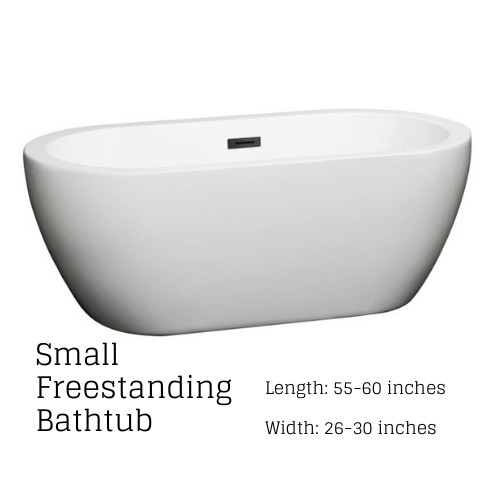
Small freestanding bathtubs are ideal for compact bathrooms or for those who want a minimalist look. They usually range from 55 to 60 inches in length, 26 to 30 inches in width, and have a depth of around 16 to 18 inches. These bathtubs are space-efficient and can fit comfortably in smaller bathrooms without sacrificing style and comfort.
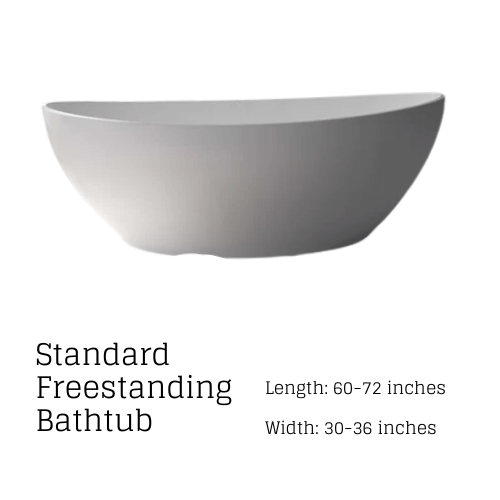
Small freestanding bathtubs are ideal for compact bathrooms or for those who want a minimalist look. They usually range from 55 to 60 inches in length, 26 to 30 inches in width, and have a depth of around 16 to 18 inches. These bathtubs are space-efficient and can fit comfortably in smaller bathrooms without sacrificing style and comfort.
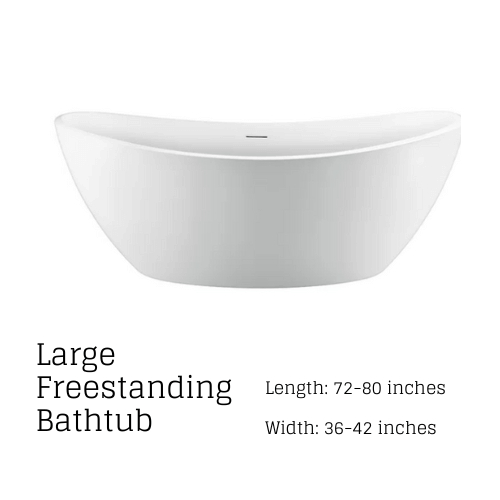
Large freestanding bathtubs are an excellent option if you have ample space and seek a more lavish bathing experience. They typically range from 72 to 80 inches in length, 36 to 42 inches in width, and have a depth of around 24 to 32 inches. These bathtubs provide a generous bathing area, perfect for relaxation and indulgence.
Shapes of Freestanding Bathtubs
Apart from size, freestanding bathtubs also come in various shapes, each offering a distinct aesthetic and comfort level:
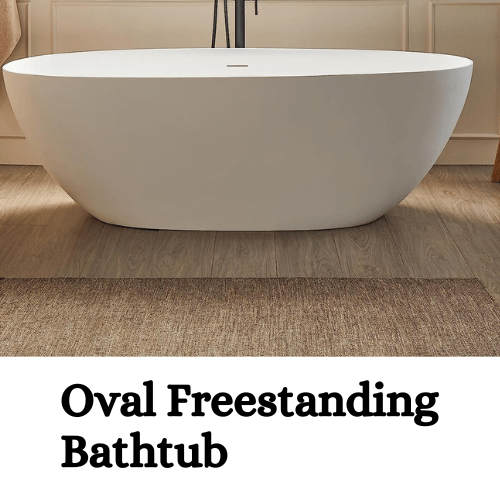
Oval-shaped freestanding bathtubs are classic and elegant, with a smooth, symmetrical design. They offer a comfortable and relaxing bathing experience, accommodating a wide range of body shapes.
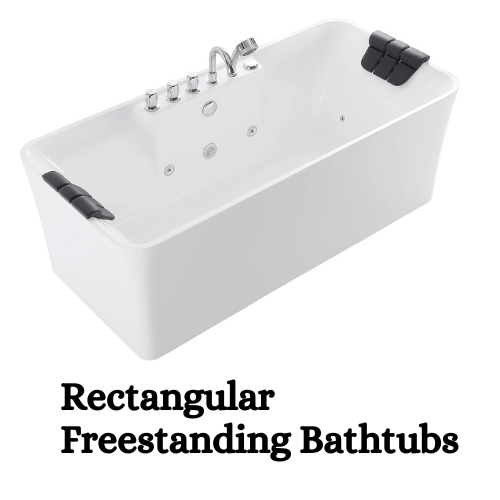
Rectangular freestanding bathtubs exude a modern and sleek look, fitting well in contemporary bathrooms. They often have straight edges, providing ample space for stretching out during a bath.

Round freestanding bathtubs are a unique and artistic choice, making a bold statement in any bathroom. They offer a cozy and intimate bathing experience.
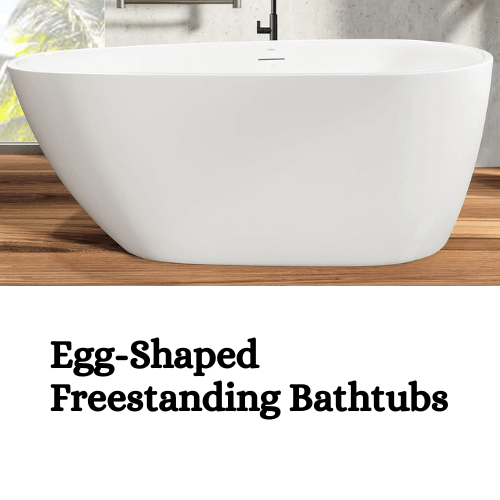
Egg-shaped freestanding bathtubs combine the best of oval and round designs, offering a sophisticated and comfortable bathing space.
What We Should Consider Bathroom Layout and Design for Freestanding Bathtub
Think about the configuration and style of your bathroom when choosing the size and shape of a standalone bathtub. Ensure enough clearance space around the tub for comfortable access and cleaning. Additionally, think about the visual impact the bathtub will have on the overall aesthetics of your bathroom.
Materials of Freestanding Bathtub
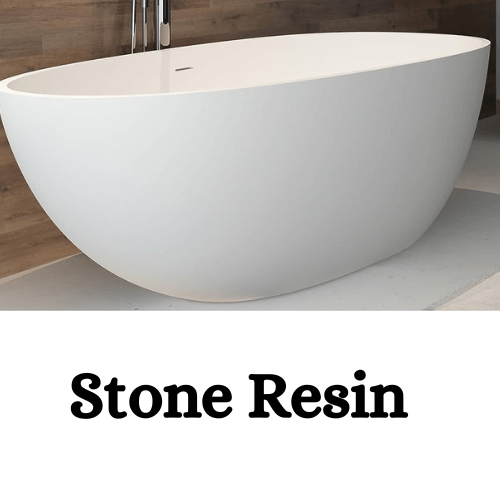
Stone resin is a popular material for freestanding bathtubs that combines natural minerals with a resin binder. The result is a durable and luxurious bathtub with a smooth, non-porous surface. Stone resin bathtubs have the appearance of natural stone, providing an elegant and high-end look to any bathroom.

Cast stone bathtubs are crafted by combining crushed limestone and resin, creating a bathtub that resembles natural stone. These bathtubs offer a luxurious and unique appearance, enhancing the overall aesthetic of the bathroom.
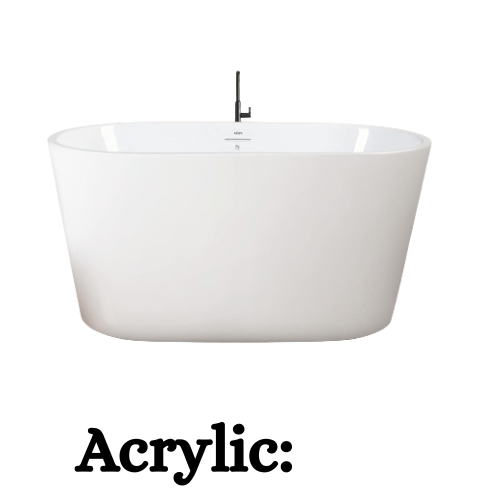
Acrylic is a lightweight and affordable material used for freestanding bathtubs. It is made from reinforced fiberglass sheets coated with acrylic, creating a smooth and glossy surface.
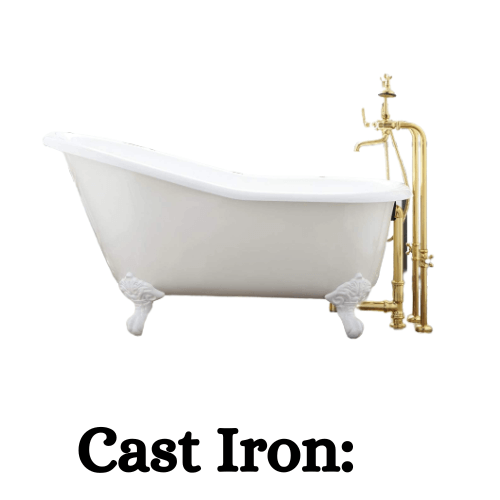
Cast iron bathtubs have a traditional and timeless appeal. They are made from molded iron and coated with enamel, providing a sturdy and classic look.
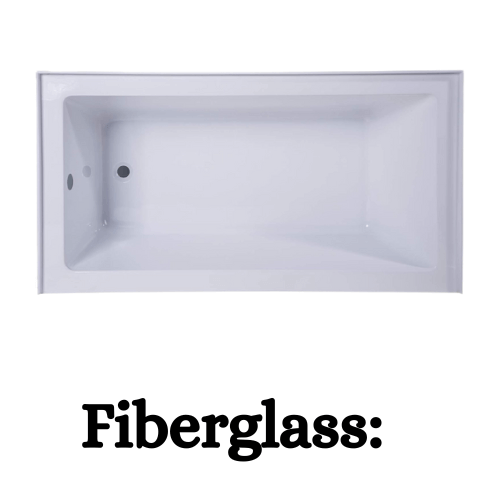
Fiberglass is a lightweight and cost-effective material used for freestanding bathtubs. It is made from layers of reinforced polyester resin and glass fibers.
How Many Styles of Bathtubs
Let’s explore some popular styles of bathtubs:
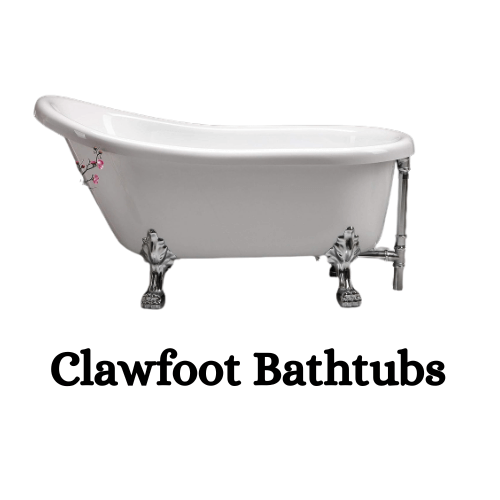
Clawfoot bathtubs are classic and iconic, characterized by their ornate feet, which resemble claws. These tubs bring a bit of historical beauty to any bathroom and are reminiscent of the Victorian era. Clawfoot bathtubs are often made of cast iron or acrylic and can be freestanding or attached to a wall.
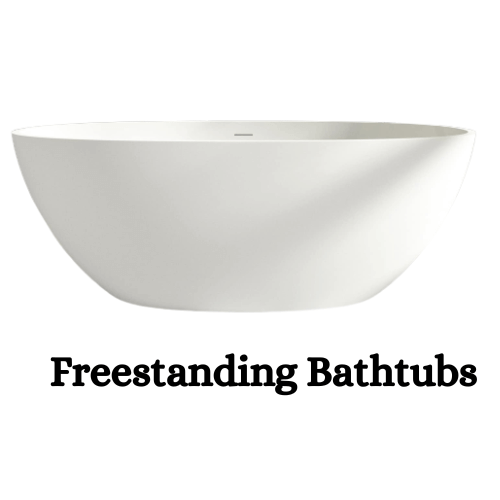
Freestanding bathtubs are standalone tubs not attached to any walls. They are adaptable and can be positioned wherever in the bathroom to produce an opulent and spa-like ambiance. Freestanding bathtubs come in various shapes, such as oval, rectangular, round, and egg-shaped, offering diverse design options.
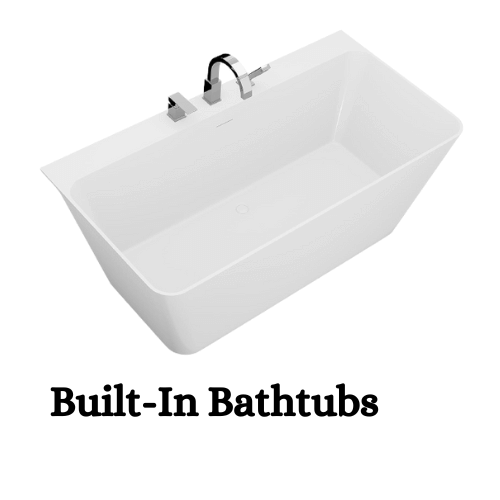
Built-in bathtubs, also known as alcove or recessed bathtubs, are designed to fit within an enclosed space surrounded by walls on three sides. They are a common choice for standard bathrooms due to their space-saving design. Built-in bathtubs are typically acrylic or fiberglass and offer various sizes and styles.
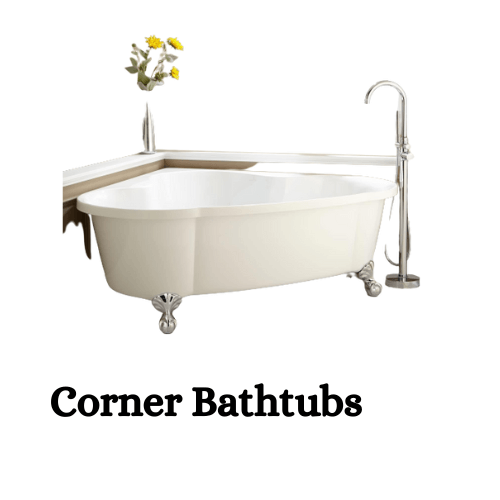
Corner bathtubs are designed to fit into a bathroom corner, optimizing space utilization. They are a great option for smaller bathrooms when making the most of the available floor space is crucial. Corner bathtubs are available in various shapes, including triangular and rounded designs.
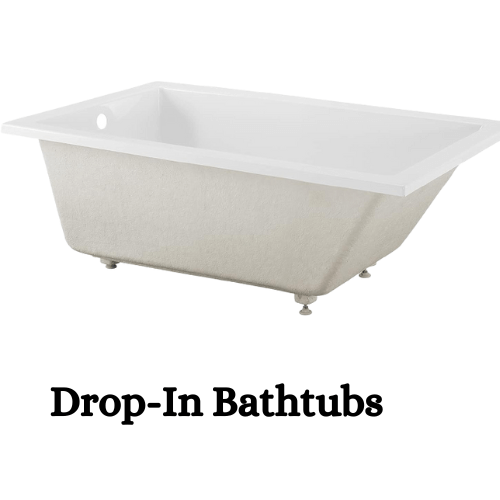
Drop-in bathtubs are installed within a deck or platform, giving them a seamless and integrated appearance. They create a sleek and modern look, and the deck surrounding the tub can serve as a functional shelf or storage area. Drop-in tubs are often made of acrylic, cast iron, or stone.

Japanese soaking tubs, also known as ofuro or deep soaking tubs, have a unique design that allows for full-body immersion. They are deeper than traditional Western bathtubs, allowing for a more relaxing and therapeutic bathing experience. Japanese soaking tubs are usually made of wood, acrylic, or fiberglass.
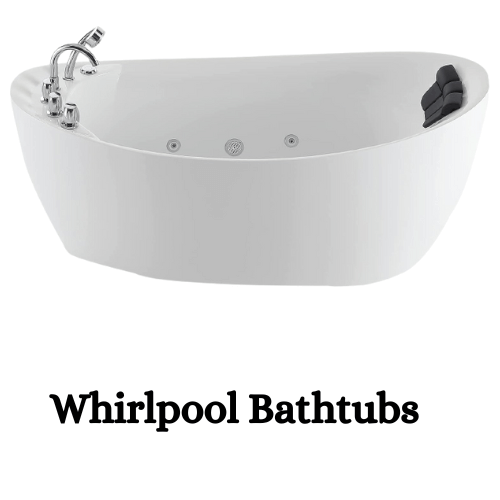
Whirlpool bathtubs, also called Jacuzzi or spa tubs, are equipped with built-in jets that create a soothing and massaging water flow. These tubs offer a therapeutic bathing experience and are beneficial for relieving stress and muscle tension. Whirlpool bathtubs come in various styles, including freestanding, built-in, and drop-in options.
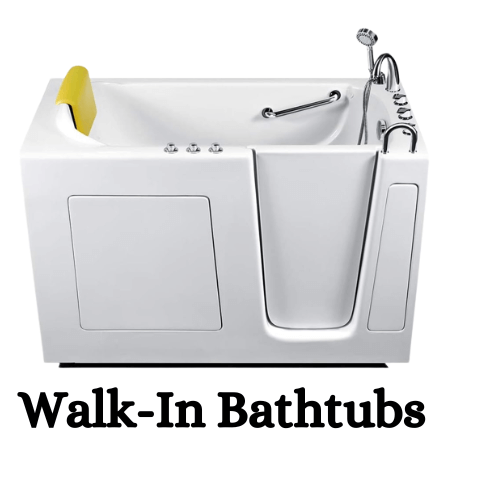
With a door on the side, walk-in bathtubs make it simple to enter and depart the tub without having to step over its edge. They are an excellent option for individuals with mobility challenges or seniors who require safer bathing solutions. Walk-in bathtubs often feature built-in seats and handrails for added convenience and safety.
Freestanding Bathtub Faucets Types
Freestanding bathtubs require specific types of faucets to complement their design and functionality. These faucets are designed to be mounted on the floor or on the tub itself, providing a stylish and functional water supply for the bathtub. Let’s explore some common types of freestanding bathtub faucets:

Floor-mounted faucets are the most popular choice for freestanding bathtubs. These faucets stand independently on the bathroom floor next to the tub. They are installed directly on the floor or on a nearby deck, and the water supply lines are concealed within the faucet’s body.
Floor-mounted faucets offer a sleek and modern look, and they are available in various finishes to match the bathroom’s overall aesthetics.
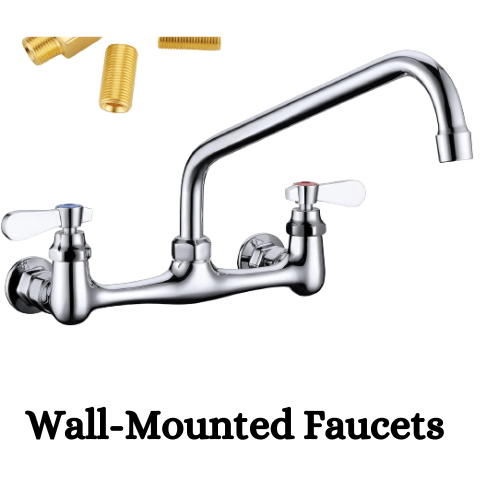
Wall-mounted faucets can also be used with freestanding bathtubs, though they require the presence of a nearby wall for installation. These faucets are mounted on the bathroom wall above the bathtub and provide water supply to the tub through a spout.
Wall-mounted faucets can add a contemporary touch to the bathroom design and create a clean and minimalist look.
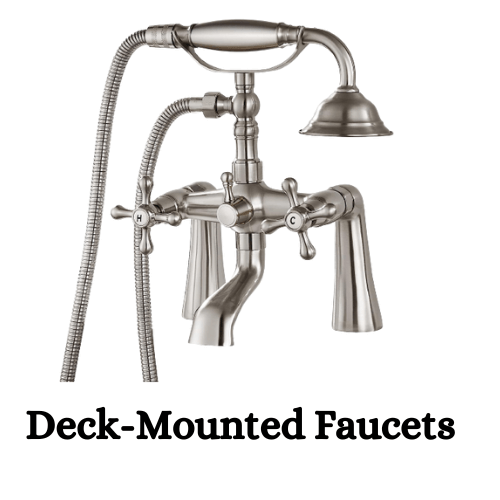
Deck-mounted faucets are installed on a deck or platform adjacent to the freestanding bathtubs. This platform can be a part of the bathtub’s design or a separate structure built to accommodate the faucet.
Deck-mounted faucets provide a convenient and accessible water supply while complementing the overall bathtub aesthetics.
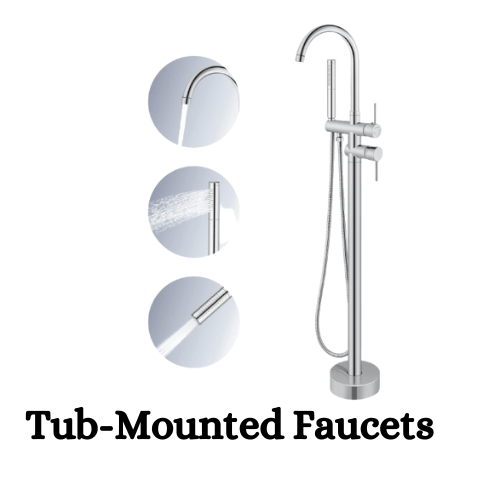
Tub-mounted faucets, also known as rim-mounted or ledge-mounted faucets, are directly attached to the bathtub’s rim. These faucets require pre-drilled holes on the tub’s edge to accommodate the faucet handles and spout.
Tub-mounted faucets offer a classic and integrated look, especially with vintage-style freestanding bathtubs.
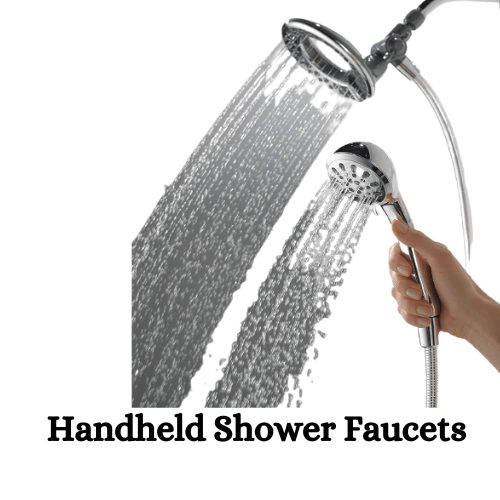
Some freestanding bathtub faucets come with a handheld showerhead attachment. These faucets allow you to switch between filling the tub and using the handheld shower for bathing or rinsing. The handheld shower faucets are convenient for cleaning the tub and provide added flexibility during bath time.
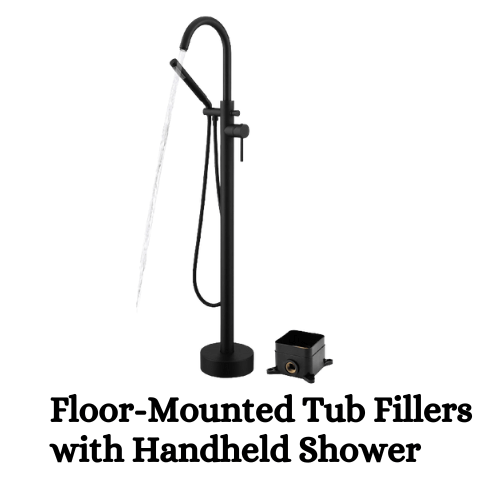
These faucets combine a floor-mounted tub filler with a separate handheld showerhead. The floor-mounted tub filler serves as the primary water supply, while the handheld showerhead offers additional functionality. This type of faucet provides a luxurious bathing experience and adds a touch of elegance to the bathroom.
How Many Freestanding Bathtub Faucet Styles
Here are some common faucet styles:
1. Single-Handle Faucets
Single-handle faucets have a sleek and minimalist design with a single lever controlling the water flow and temperature. They are easy to use and ideal for contemporary and modern bathroom settings.
2. Double-Handle Faucets
Double-handle faucets feature separate handles for hot and cold water, allowing for more precise temperature control. They often have a classic and traditional appearance, making them popular for vintage and traditional bathrooms.
3. Widespread Faucets
The spout is installed separately from the handles on widespread faucets, which have separate hot and cold knobs. It creates a more spread-out look, offering a sense of elegance and sophistication to the bathroom.
4. Center-Set Faucets
Center-set faucets combine the spout and handles into a single unit, providing a compact and streamlined design. They are easy to install and are suitable for bathrooms with limited space.
5. Wall-Mounted Faucets
Wall-mounted faucets are installed on the bathroom wall rather than on the countertop or sink. They create a clean and minimalist look, ideal for contemporary and modern bathroom styles.
6. Vessel Sink Faucets
Vessel sink faucets are specifically designed for vessel sinks, which sit on top of the countertop. These faucets are typically taller to accommodate the height of the vessel sink.
7. Bridge Faucets
Bridge faucets have a vintage-inspired design with a bridge-like structure that connects the hot and cold handles to the spout. They offer a classic and timeless look, perfect for traditional and farmhouse-style bathrooms.
How to Choose Freestanding Bathtub Faucet
Here are some essential tips for selecting the perfect faucet:
Bathroom Style
- Mounting Options
- Number of Handles
- Faucet Finish
- Quality and Brand
- Spout Height and Reach
- Water Efficiency
- Budget
Freestanding Bathtub Faucet Materials
Here are common materials used for freestanding bathtub faucets:
- Brass
- Stainless Steel
- Chrome
- Nickel
- Bronze
- Copper
- PVD Finishes
- Plastic
Maintenance and Care
Your freestanding bathtub will last longer and continue to appear brand new with regular maintenance. Follow these tips to ensure its longevity:
- Regularly clean the tub with a non-abrasive, mild cleaner to avoid damage to the finish.
- Avoid using harsh chemicals that might harm the tub’s material.
- For stone or copper tubs, apply a sealant to protect the surface and prevent staining.
- Check for any leaks or cracks and address them promptly to prevent further damage.
How to install A freestanding Bathtub
Here are the steps to guide you through the installation process:
1. Preparation
Measure the bathroom space to ensure the freestanding bathtub will fit comfortably. Clear the area and ensure the floor is level and able to support the weight of the tub and water.
2. Positioning
Decide on the ideal location for the bathtub. Keep in mind the proximity to plumbing lines and drainage, as well as any structural elements that might affect the installation.
3. Floor Reinforcement (if needed)
For heavier bathtubs like those made of cast iron or stone, reinforce the floor beneath the tub area to provide adequate support. Consult a professional if necessary.
4. Plumbing Preparation
Locate the water supply and drain lines to match the tub’s position. Install necessary plumbing fixtures and fittings for the freestanding tub.
5. Test Fit
Place the bathtub in its designated spot without connecting any plumbing to ensure it fits properly and aligns with the intended layout.
6. Install Faucet
Install the chosen faucet style according to the manufacturer’s guidelines. For floor-mounted faucets, ensure proper anchoring and alignment.
7. Secure the Tub
Once all plumbing connections are complete, secure the freestanding tub in place. Some tubs may come with adjustable feet for leveling; use them as needed.
8. Water Testing
Fill the bathtub with water and check for any leaks or issues. Address any problems before completing the installation.
9. Seal and Finish
Caulk around the base of the tub to prevent water seepage and provide a finished look. Clean up any excess caulk or debris.
10. Final Check
Double-check all connections and ensure the tub is stable and level before finalizing the installation.
11. Inspect and Enjoy
Once the installation is complete and all connections are secure, inspect the bathtub for any signs of leaks or issues.
How Many Types of Freestanding Bathtub Drains
Here are common types of freestanding bathtub drains:
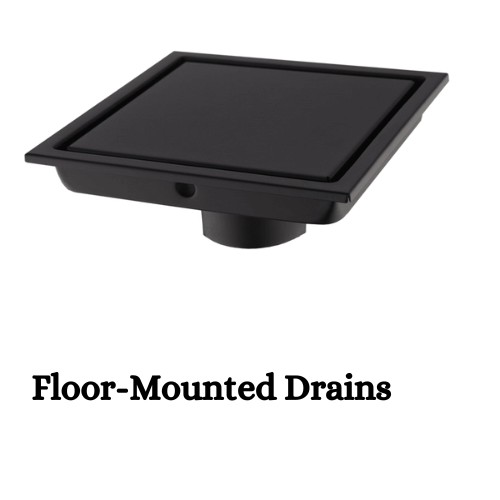
Floor-mounted drains are a popular choice for freestanding bathtubs. These drains are installed directly on the bathroom floor, usually near the bathtub’s base. They are discreet and do not obstruct the bathtub’s aesthetic, allowing for a clean and seamless look. To ensure proper water drainage, floor-mounted drains are connected to the bathtub’s waste outlet.

By pressing down on the drain cover, the stopper mechanism on pop-up drains can be simply opened or closed. When the stopper is open, water flows freely through the drain, and when it is closed, it prevents water from draining out of the bathtub. Pop-up drains are commonly used with freestanding bathtubs that do not have an integrated overflow system.
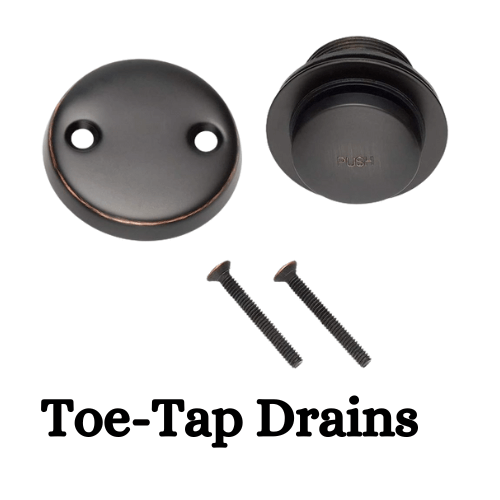
Toe-tap drains, also known as foot-activated drains, have a mechanism that allows you to open or close the drain by pressing it with your foot. This hands-free operation is convenient and practical, especially when your hands are wet or occupied. Toe-tap drains are typically used with modern and contemporary freestanding bathtubs.
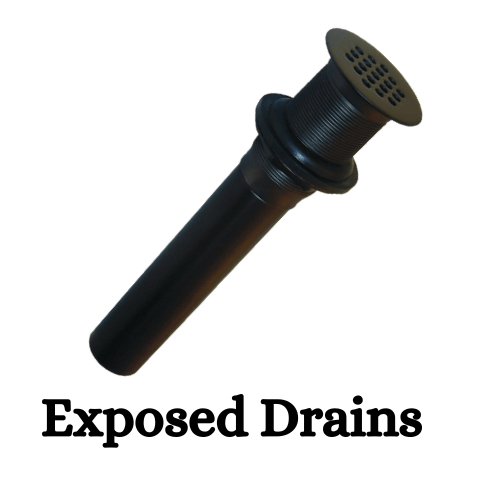
Some freestanding bathtubs feature exposed drains, where the drain assembly is visible and becomes part of the bathtub’s design. Exposed drains are often made of brass or other decorative materials, adding an artistic element to the overall look of the tub.

Some freestanding bathtubs feature exposed drains, where the drain assembly is visible and becomes part of the bathtub’s design. Exposed drains are often made of brass or other decorative materials, adding an artistic element to the overall look of the tub.
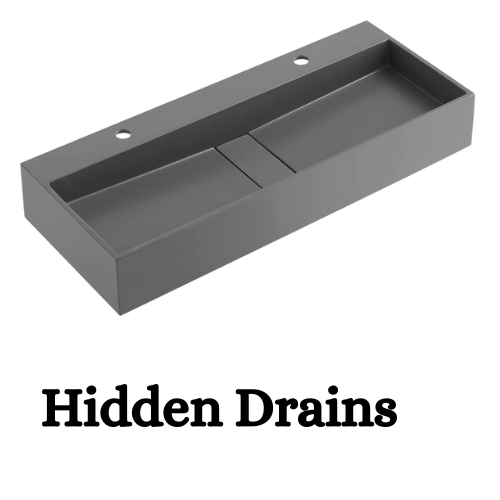
In some modern freestanding bathtubs, the drain is hidden under a removable cover or panel, creating a seamless and minimalist appearance. Hidden drains are a popular choice for sleek and contemporary bathroom designs.
FAQs About Freestanding Bathtub
Can a modern freestanding bathtub also be a shower?
Yes, a modern freestanding bathtub can also function as a shower with the addition of a floor-mounted or wall-mounted showerhead and a handheld shower attachment. This dual-functionality provides versatility and allows for a relaxing bath or a quick shower as needed.
Are freestanding bathtubs comfortable?
Freestanding bathtubs can be incredibly comfortable. Their spacious design and ergonomic shapes allow for full-body immersion and relaxation. Many freestanding bathtubs are also designed with sloped backs and contoured interiors, enhancing comfort during baths. However, comfort can vary depending on the specific bathtub’s design and the user’s preferences.
How much do Freestanding Bathtubs Cost?
Freestanding bathtubs can range from $800 to $5,000 or more. Luxury and designer options can cost even more.
What are freestanding bathtubs made of?
1. Acrylic
2. Cast Iron
3. Stone Resin
4. Copper
5. Brass
6. Fiberglass
7. Stone
How many people can a freestanding bathtub fit?
Small Size (Single-Person): Small freestanding bathtubs typically have dimensions around 55 to 60 inches in length and 27 to 32 inches in width.
Medium Size (Two-Person): They have dimensions ranging from 60 to 72 inches in length and 30 to 36 inches in width.
Large Size (Multiple Persons): These larger tubs can be up to 72 inches or more in length and 36 inches or more in width.
How far should the distance be between freestanding tub and wall?
A common distance between a freestanding bathtub and the wall is typically around 15 to 18 inches (approximately 38 to 46 centimeters).
Can freestanding tubs come with jets?
Yes, freestanding tubs can come with jets. These bathtubs are known as “freestanding whirlpool tubs” or “freestanding jetted tubs.” They offer the luxurious and therapeutic experience of a whirlpool or jacuzzi bath in a freestanding design. The jets in these tubs create a soothing and massaging water flow, providing relaxation and relieving muscle tension. Freestanding tubs with jets are a popular choice for those seeking a spa-like bathing experience in the comfort of their own home.
Final Thoughts
A freestanding bathtub is a statement piece that can transform your bathroom into a luxurious sanctuary. By considering the size, material, style, and comfort, you can find the perfect freestanding bathtub that complements your bathroom space and reflects your personal style.
Remember to perform regular maintenance and hire professionals for installation to ensure your bathtub remains in pristine condition for many years to come. This comprehensive book has given you the knowledge you need to make wise choices and design a gorgeous bathroom that will make an impression on everyone who enters.
Happy bathtub hunting!


